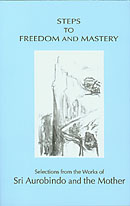
Steps to Freedom and Mastery
Publisher: Sri Aurobindo Ashram Publication Department, Pondicherry
The perennial thirst of man is freedom; and for some whose natures are enterprising and attuned to advancement, that need for freedom becomes a quest for self-mastery. What is man trying to be free of? This is a subject dealt with by philosophy and yoga from their embryonic beginnings to present times.
This book, Steps to Freedom and Mastery by Dr A. S. Dalal, is a compilation from the writings of Sri Aurobindo and the Mother. To understand and profit from a book of this genre it is good to recapitulate as far as possible Sri Aurobindo’s philosophical journey that, beginning with spiritual experiences of lore, paves the way for his revolutionary theory of the yoga of transformation.
Sri Aurobindo is a Vedantist in a very broad sense; as an Acharya, when he establishes his philosophy in The Life Divine, every chapter is based on a sloka from the Vedas or the Upanishads. But Sri Aurobindo is not a Vedantist in the orthodox sense of the word, as he takes the quintessence of every path that leads to God-realisation or any major school of ideas that takes humanity closer to the truth, irrespective of whether they are based on Vedantic text or not, to arrive at a more catholic truth that answers man’s every query.
According to traditional Indian schools of thought, man’s soul or the individual God in him is caught in a net of karma. This net consists of Sanchita Karma, Kriyamana Karma, and Prarabdha Karma. That which we know as fate or destiny is the prarabdha aspect, that portion of Sanchita Karma that influences the current incarnation. Man’s perennial thirst for freedom is nothing but the perpetual effort of the soul to escape this net and unite with its origin, whether that is described as a being or a non-being or a field of energy that is the cause of this universe.
The orthodox schools of yoga or philosophy teach man to escape this net of karma, but Sri Aurobindo and the Mother developed the pioneering system of Integral Yoga. Their Yoga not only shows man the way through the net back to his origin, but makes him work on the very substance of the net in which he is caught and change it to a luminous substance.
This great and difficult endeavour is only possible by uniting our will with that of the Creatrix of the universe, which in Sri Aurobindo’s Yoga is embodied by the Mother. It is only she who knows the path that a soul will take to return to its origin. Therefore, they have not prescribed ONE demarcated path for every soul but have embraced the whole spectrum of human quest and realisation.
This thought brings us back to the book under review. The number of paths being unimaginably vast, such a meaningful compilation of this kind is of great worth. The passages will help many people to see their own paths more clearly and help them understand their efforts towards freedom and mastery. The book begins by informing us about the general state of being of a human, or the ordinary human existence. We are introduced then to the idea of becoming conscious of this state in ourselves and of the basic configuration of our being. Next, through a brief passage from the Mother, we understand that the feeling of the worthlessness of all one sees and does can be the igniting spark towards understanding oneself and life. Becoming conscious of oneself leads to being conscious of the need for freedom and for some mastery too. Then the book takes up the purification of the being, which is a step towards mastery. At this point questions might arise such as “Why purification?” For freedom and mastery one needs to be purified of what?
Purification means getting rid of undesirable elements, thereby leaving a substance more homogeneous and less dense. In our context it means rejecting all activities that prevent the will of man from moving towards God-realisation and mastery. As a result, it is nothing but making the net of karma that imprisons man less dense and more homogeneous, allowing him to move towards his aim.
The subsequent passages lead us to an understanding of detachment from all one does, which is the first state of freedom. At this stage in one’s spiritual practice one may choose to delimit one’s area of action, a process which facilitates detachment from action. Having achieved that state of freedom, that point where the net of karma has no hold on the seeker, one chooses to take a step further on the journey, towards mastery. Eventually there comes a point in the spiritual practice when one is ready to act in an even larger state of freedom, eliminating all delimitations. This brings us to the next chapter that concerns the abolition of the ego. Absolute mastery can be achieved only through this liberation and a radical transformation of the nature. This, in other words, means a new birth of the individual.
The last observation I would like to make to readers is that the editor has presented each subject from several different angles or perspectives, which makes the book purposeful for people at varied stages in their lives, and which serves to highlight the integral approach of Sri Aurobindo and the Mother.
— Shyama Prasad
After completing her studies at SAICE Shyama joined the Ashram, where she works at the Dining Room. She enjoys theatre, dance, music, drawing, and writing, and has written articles for the SAICE alumni journal, The Golden Chain.
(Sabda holds the copyright for this review; for more details click here)





